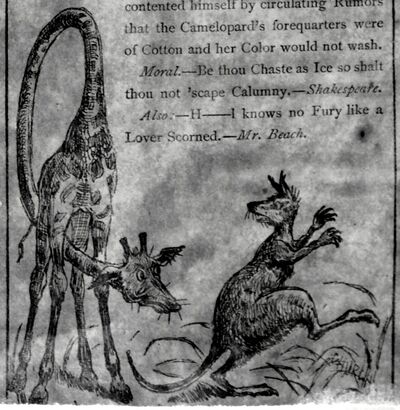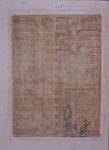< Madame Blavatsky-Spirit Photography in Paris (continued from page 4-222) >
own management, and then bind themselves to sign a full retractation of their present fanaticism of incredulity, and to “give in to spirits’’ (under penalty of facing a similar pistol-shot for every learned scientist who should refuse to sign), then I might be willing to accept John King’s proposition, and I have sufficient faith and conviction to be able to do so without a tremor of nerve, or a shadow of doubt as to the result. But for a mere superfluous test experiment, for us who need no such further evidences (to be written to The Spiritualist, and to be related to people who will not believe, “even though one should rise from the dead”), I decline to pull that foolish trigger, even on John King’s own invitation.
Feb. 3.—Through the past week we have had splendid success in our photography in the dark. We have got several fine pictures of “Glaucus.” His was a success on the first day of his posing (Jan. 30). It presents the same seraphic face as in the bust. Every day there is variation in the pose and accessories. A large and handsome plain gold cross had been given to him at the beginning of the seance on that 30th Jan. by one of our number (we are three). This had been done in pursuance of his expression of a wish for a cross, through the voice of John King. This cross appears in all the pictures, not hanging from his neck by his chain, but affixed to some part of his drapery as a sort of badge. The distribution of the drapery, and the quantity and parts of the shoulders and bust shown, differ in all of them, as also the direction in which the face is turned. In one of these (that of yesterday) both forms appear, standing side by side, that of “Glaucus” and that of “Angela,” both beautiful indeed. There had been a similar one the day before, but the plate got broken in the course of the development, which always takes place at once on the spot. The pictures are often very slow in coming out; once it was forty-two minutes. The poses are now of about forty-five seconds to two minutes. It is John King who always directs when to uncap and recap the camera. We were told that there was great distress amongst the invisible one present when the plate got broken; but they promised to try to repeat the picture next day. “Angela” always exhibits some or others of the flowers (natural ones, namely, three roses, a camellia, and several sprigs of narcissus), which have been given her, and which they say-they preserve unfaded, distributed in her hair or about her person. Yesterday we observed on the developed plate what seemed quite different flowers or leaves, fringing, as it were, the upper edge of her drapery, across her bosom. She often writes after the seance through the hand of Mrs. Firman. As the latter sat down for that purpose I asked “Angela” where those flowers had come from. She wrote that she made them from the roses which had been given to her last week. We always now lay in the cabinet, two or three long pieces of gauze stuff, which the spirits employ very gracefully in their poses, and then leave in a heap on the floor where they had stood. Sometimes they throw them to us. On two occasions we were directed to keep in our laps, and hold firmly, the drapery during the pose. Yet a double of the drapery appeared in the pictures just as when they employ the original pieces. Compare this with the facts mentioned in my last about the spirit ability to reproduce material articles from “the essence” of other ones, and particularly the incident of the two oriental handkerchiefs at Madame Blavatsky’s.
Will any of my friends about 38, Great Russell-street cling still to the marble or plaster cast theory as to the origin of the paraffin moulds and busts, when we have so many variations, repetitions, in photography of “Angela” and “Glaucus,” the same as in their busts, yet never identical from one day to another?
One little circumstance may be worth noting. In all our seances Firman is in a trance sleep, lying on a mattress in the cabinet. A few mesmerising passes from the Count suffice to throw him into and reawaken him from that condition. We have observed that his trance is evidently much deeper—that he is much further gone in trance—at these photographic seances than ever before. It is real, hard, and protracted work for the Count to get him back, and he wakes in a state of utter daze. It is some time before he can sit up. When lifted to his seat on the mattress, if not held up from behind, he will instantly fall back, having no power to keep himself erect. He is evidently heavily drawn upon when “John King” has to do the double work of materialising the spirit forms and making the (to us invisible) light for the photography. He has said that he gets it chiefly out of the medium’s brain. Does the phosphorus in the brain play any part in this operation? “John King,” in reply to a question, admitted that it had something to do with it. You will remember how often we have witnessed the fading light of his well-known “lamp” revive and brighten as he will apply it to the head of the Count, who is very mesmeric. An English reader wrote me last week how the idea had occurred to him that perhaps light might be got by spirits out of the brains of animals just killed, and that he took that of a bullock, placed in a basin, to the medium Williams, whose familiarly known spirit Joey did exhibit a considerable body of light just above the basin, which was reflected in the chimney-glass, and which lasted over an hour, when “Joey” said they could not get any more light out of it. My correspondent suggested our making trial of that as an experiment in our photography, in the hope of its economising the available “power,” so as to enable more of it to be utilised in the materialisation, as distinct from the light-production. But John King did not receive the suggestion with favour. “Yes,” he said, “it is a matter of brains, but human brains, not those of dead animals.” I understand that he has since expressed at Williams’s a willingness to try the experiment.
No success yet with the promised photograph of my mother, notwithstanding daily attempts. Only an occasional slight, confused impression on the plate. But the same was the case at first with “Angela” and “Alexandrine,” who now come splendidly, and without fail. On the 13th December “Angela” wrote that she was “quite discouraged;” but she was made to persevere.
More in a few days.
Paris, Feb, 4.
Answer to Correspondents
A correspondent writes from Bath, expressing a regret that phtographic likenesses of Madama Blavatsky are not purchasable in this country.
The Unknown in Mediumship
Sir,—I am indebted to the kindness of a friend in England for a copy of your paper, just now at hand, of October 5th, in which “M.A. (Oxon),” confesses his inability to solve the problems to which I had invited his attention. I am not disappointed. Those problems admit of no solution that would not be fatal to the enthusiasm which animates bis pen. The motive power of modern Spiritualism is what Christians call “saving faith,” that is, “faith” in the unknown, which fabricates “the evidence of things unseen” (Heb. xi. 1).
The miracle before our eyes (of knowledge and chemical skill) is admitted. All else is unknown and unprovable. In no case can we know how many “spirits” are present, or their sex. We do not know where they originated, nor whether they bring to us any knowledge of persons, dates, and places, except those they learnt during their control of mediums; and thus, nine-tenths of the factors are unknown. I am not surprised, when one of the foremost devotees of this modern “ism” owns up to his inability to meet the issues raised in my previous paper. And while I concede the facilities of his pen, and his “familiarity with requests of all kinds, and from persons in all parts of the globe,” it was, after this confession of inability, hardly necessary, perhaps, for “M.A. (Oxon),” to refer me to any newly projected volume of his “Researches” for any light on problems he does not understand, and which he could not solve if he did comprehend them, without an utter annihilation of his own faith in the unknown.
Quincy, Mass., U.S.A., November 17th, 1877.
The Kangaroo and the Camelopard
...

Editor's notes
Sources
-
London Spiritualist, No. 276, December 7, 1877, p. 275


